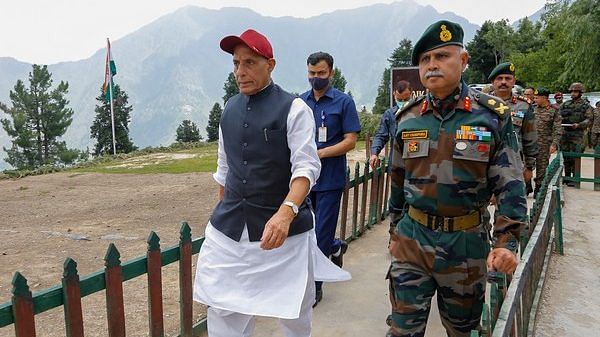Even as the much anticipated announcement of India’s second Chief of Defence Staff enters its seventh month, there are other equally important links missing from the country’s higher national security management. While the focus remains on the next CDS, the absence of a National Security Strategy and revised Raksha Mantri’s Operational Directives means that the Indian Armed Forces continue to undertake plans and operate in an ad hoc manner in order to fulfil commitments. The NSS is, of course, the oldest of the missing links in the national security circuit. But given the current environment, Raksha Mantri’s Operational Directives are easily the most important.
The enlarged selection pool for the next CDS is a severe negation on the abilities of the current chiefs of the three Services. And it has of course come in for a scathing comment by Lt Gen HS Panag (retd). The fanfare that went with the announcement of late Gen Bipin Rawat as CDS on 31 December 2019 raised expectations about the furtherance of defence reforms. But the only ‘reform’ since then has been the announcement of a bizarre four-year contractual service scheme — named Tour of Duty or ‘Agnipath’ — for soldiers. The contours of the contract make it apparent that this scheme is not a Ministry of Defence creation.
The missing NSS
The brazenness displayed in conjuring up a scheme of such alien proportions is also apparent in the continued delays in coming up with a comprehensive National Security Strategy (NSS). India is of course the only major military power that has never articulated or published an NSS. There have been many initiatives announced to come up with a comprehensive NSS, but they’ve always run aground for some reason or the other. The least of which is the inability of a department to agree fundamentals with another. As a result of which India continues to plan and execute national security formulae without a comprehensive long term plan or vision.
“The Indian state does not possess an overarching National Security Strategy that comprehensively assesses the challenges to the country’s security and spells out policies to deal effectively with them…the state relies on ad hoc responses of questionable utility,” former foreign secretary Shyam Saran expressed searingly. Despite repeated attempts and announcements, the roadblocks of unwillingness, or ignorance, have hampered progress towards formulating the elusive NSS. An elaborate NSS requires the joint effort of multiple departments and fields of study, not the least of which is finance and human resources, science and space. It is not a military endeavour alone.
The effort, however, seems to have been entirely military thus far. So it was in 2007 that the Headquarters of the Integrated Defence Staff produced the first draft of the proposed NSS. The draft lay unattended until it was dusted in 2018 by the National Security Advisory Board, revised and presented to the then recently constituted Defence Planning Committee. Since October 2019, the draft NSS has remained just as it was — unanalysed by other departments pending approval. The NSS is only as good as the wider departmental circle that contributes to its formulation. Progress has been tardy.
Also read: Shah’s right, India lacks formal defence policy. Past govts were busy avoiding liability
The elusive Op Directive
The three armed forces are entirely dependent on the Raksha Mantri’s Operational Directives for political direction in planning for an all-out war, or any other circumstances. It is the most important political directive for operational planning. And in more than a decade, it has not been updated to cater for newer challenges and changed circumstances.
As the former Chief of Army Staff Gen N.C. Vij wrote: “The only political direction to the Armed Forces in existence is Raksha Mantri’s operational Directive of 2009. It is now dated and hence needs to be revised. It lays down that, ‘We should be prepared to fight on both fronts simultaneously a war at 30 days (intense) and 60 days (normal) rates’.”
The revisions are mired in a dispute between the military and civilian side of the Ministry of Defence, with both unwilling to put pen to paper on the exact duration of India’s planning for conflict, on both fronts. For a written commitment from either binds them to the exact level of planning, hence funds, and therefore budgetary allocations. Not that allocations have been particularly generous in terms of long-term planning. While the Republic Day Parade may generate great eyeballs with sparkling brass and gleaming flypasts, the mundane question of ammunition stocks remains a matter of grave concern.
Skills displayed along a remodelled Rajpath, New Delhi, on 26 January have no bearing on operational capabilities, even as they may make some chests swell inches. Small arms ammunition stocks should become the first focus of attention, and only then will the MoD come to any conclusion on the number of days India could sustain a two-front war. And then issue at least one of those elusive documents, Raksha Mantri’s Operational Directive.
Manvendra Singh is a Congress leader, Editor-in-Chief of Defence & Security Alert and Chairman, Soldier Welfare Advisory Committee, Rajasthan. He tweets @ManvendraJasol. Views are personal.
(Edited by Prashant)



